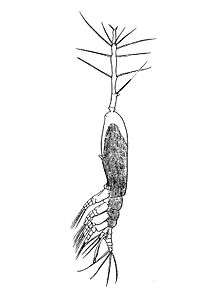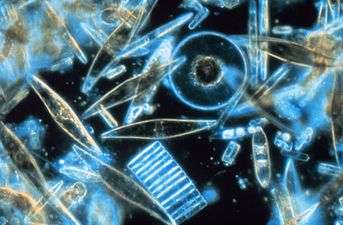Monstrilloida
| Monstrilloida | |
|---|---|
 | |
| Monstrilla longiremis | |
| Scientific classification | |
| Kingdom: | Animalia |
| Phylum: | Arthropoda |
| Subphylum: | Crustacea |
| Class: | Maxillopoda |
| Subclass: | Copepoda |
| Order: | Monstrilloida G. O. Sars, 1901 [1] |
| Family: | Monstrillidae Dana, 1849 [2] |
| Genera | |
| |
Monstrilloida is an order of copepods with a cosmopolitan distribution in the world's oceans. The order contains a single family, Monstrillidae;[1] the family Thaumatopsyllidae was formerly included in the order, but is now usually placed in the Cyclopoida.[3] The taxonomy of the family is undergoing a period of revision,[4] although some necessary changes are apparent; for instance, the genus Strilloma is now considered a taxonomic synonym of Monstrilla, the largest genus.[5]
The order is poorly known, biologically and ecologically, although the life cycle is known to differ from that of all other copepods.[6] The larvae are parasites of benthic polychaetes and gastropods, while the adults are planktonic and incapable of feeding, functioning solely to reproduce.[7]
The family Monstrillidae is characterised by having a well-developed fourth pair of swimming legs, but a rudimentary or absent fifth pair. Adults have no oral appendages, and the mouth leads only to a short, blind pharynx. Females carry a long pair of spines to which the eggs are attached, while males have a "genital protuberance, which is provided with lappets"; in both sexes, the genitalia are very different from those of all other copepods.[8]
References
- 1 2 "Monstrilloida Sars, 1901". Integrated Taxonomic Information System. Retrieved July 8, 2011.
- ↑ "Monstrillidae Dana, 1849". Integrated Taxonomic Information System. Retrieved July 8, 2011.
- ↑ J. W. Martin & G. E. Davis (2001). An Updated Classification of the Recent Crustacea (PDF). Natural History Museum of Los Angeles County. pp. 1–132.
- ↑ E. Suárez-Morales & J. B. Escamilla (2001). "Taxonomic report on some monstrilloids (Copepoda, Monstrilloida) from southeast Mexico with the description of a new species of Monstrilla". Journal of Natural History. 35 (10): 1433–1445. doi:10.1080/002229301317067629.
- ↑ Eduardo Suárez-Morales & Rebeca Gasca (2004). "On the invalidity of Strilloma Isaac (Copepoda: Monstrilloida): observations from the type species" (PDF). Zoological Studies. 43 (2): 292–299.
- ↑ Cristina de Oliveira Dias (1996). "Monstrilloida (Copepoda) off the Brazilian coast". Hydrobiologia. 324 (3): 253–256. doi:10.1007/BF00016397.
- ↑ E. Suárez-Morales & R. Palomares-García (1995). "A new species of Monstrilla (Copepoda: Monstrilloida) from a coastal system of the Baja California Peninsula, Mexico". Journal of Plankton Research. 17 (4): 745–752. doi:10.1093/plankt/17.4.745.
- ↑ Charles C. Davis (1949). "A primary revision of the Monstrilloidea, with descriptions of two new species". Transactions of the American Microscopical Society. 68 (3): 245–255. doi:10.2307/3223221. JSTOR 3223221.
